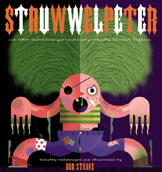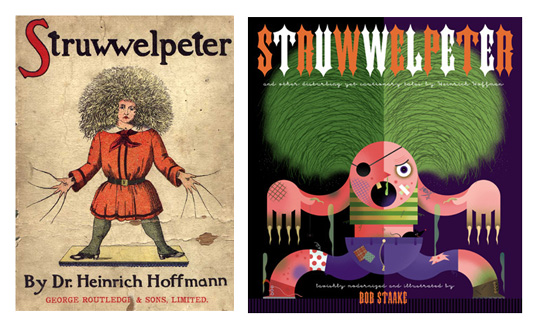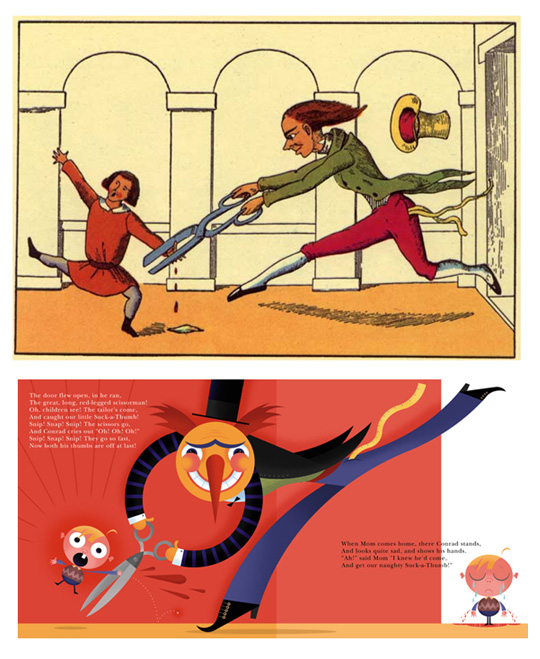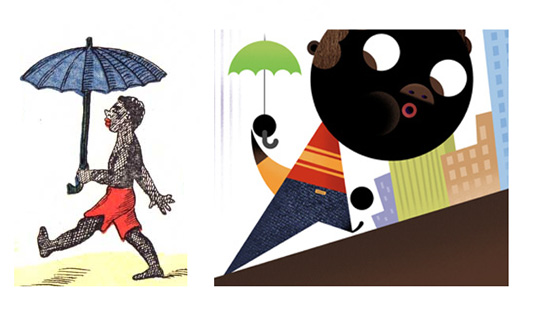
| The Stories I Background I Buy The Book I About The Artist I Contact |
| The Struwwelpeter Stories |
| Slovenly Peter |
| Cruel Frederick |
| Pauline And The Matches |
| The Inky Boys |
| The Wild Hunstman's Tale |
| The Thumb Sucker |
| Augustus Who Would Not Eat |
| Fussy Philip |
| Hanns Stare- In- The- Air |
| Flying Robert |
|
All artwork and translated textual adaptation is © copyright 2005 by bob staake -- all rights reserved
Help get the Struwwelpeter word out! Mention us on your web site or blog!
What's the Media saying About 'Struwwelpeter'?
"Staake's latest book, Struwwelpeter, (is) his best work yet. It's my favorite book of the year."
"It's like 'Scared Straight' for toddlers."
"Staake renders tribute to Hoffmann by reillustrating the 10 (Struwwelpeter) poems. In his highly geometrical style, figures and objects are constructed of brightly colored circles, triangles, rectangles, ellipses, and so forth, and placed on backdrops alive with flat, colored shapes. Although he essays perspective only on the last page of "Slovenly Peter," Staake displays compositional flair and imagination nearly everywhere; see, in particular, the second page of "Hans Stare- in- the- Air." The rhymes are probably still too much for very little children; Staake's pictures, on the other hand, are less scary and more child-friendly than Hoffmann's."
"Standing in stark contrast to anything I was read as a child, (is) the picture book Struwwelpeter ... wonderfully illustrated by Bob Staake"
|
|
Background
Originally written 160+ years ago, Heinrich Hoffmann's cult-classic book of morality tales, 'Der Struwwelpeter' lives on in this new adaptation by Bob Staake and published by Fantagraphics Books.
Your may be interested in learning how Hoffmann originally came about creating this bizarre children's book:
Dr. Heinrich Hoffmann, a Frankfurt 'medical man of the lunatic asylum', wrote and illustrated The Struwwelpeter (ShockHeaded Peter) more than 150 years ago because he couldn't find anything on the shelves to fire the imagination of his children. Below, he recounts how he came to write "The Struwwelpeter": "Towards Christmas in the year 1844, when my eldest son was three years old, I went to town with the intention to buy as a present for him a picture book, which should be adapted to the little fellow's powers of comprehension. But what did I find? Long tales, stupid stories, beginning and ending with admonitions like 'the good child must be truthful' or children must keep clean' ect. But I lost all patience when I found a folio volume where a bench, a chair, a jug, and many other things were drawn and under each picture neatly written: 'half, a third, or a tenth of the natural size'". A child, for whose amusement you are painting a bench, will think that a real bench; he has not and need not have an idea of the full size of a real bench. The child does not reason abstractly." "That evening I nevertheless brought home a book, and handing it over to my wife, said "There is what you wished for the little one". She took it, calling out rather amazed "Well, that is a note-book with blank leaves" - "Just so, but we are going to make a book out of it". And it happened thus: I was then obliged to practice in town where I was often brought into contact with children. Now it certainly is a difficult thing for a Doctor to make their little ones from 3 to 5 years feel at their ease with him, because when they are in good health, the medical man and the chimney-sweep are very often made bug-bears of. 'My dear, if you are naughty the chimney-sweep will carry you off' or 'Child, if you eat too much, the Doctor will come with his nasty medicine'. The consequence is, that the little angel, when ill, begins to cry violently and to struggle as soon as the physician enters the room. On such occasions a slip of paper and a pencil generally came to my assistance. A story, invented on the spur of the moment, illustrated with a few touches of the pencil and humorously related, will calm the little antagonist, dry his tears, and allow the medical man to do his duty." "In this manner most of Struwwelpeter's absurd scenes originated. Some of them were later inventions, sketched in the same impulsive manner, without the least intention on my part of literary fame. The book was bound, put under the Christmas-tree, and the effect on the boy was just what I expected."
>>> Pixel Surgeon asks Bob Staake what prompted him to re-examine Struwwelpeter |




